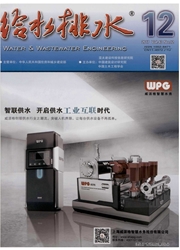

 中文摘要:
中文摘要:
针对西北村镇集雨窖水污染现状,采用粗滤慢滤组合净水工艺进行了现场试验研究。通过自然挂膜确定了膜的生物稳定期,并对其影响因素进行了分析。结果表明:粗滤慢滤小型净水装置能有效地处理西北村镇集雨窖水。对窖水的浊度、有机物、氨氮及微生物学指标有良好的去除效果。在粗滤慢滤装置滤速控制在0.1m/h的情况下,生物膜生长期为40~50d。在生物膜形成之后,出水氨氮平均0.285mg/L,氨氮去除率最高达78.359/6;出水CODMn平均2.27mg/L,CODMn去除率最高达到61.58%。出水浊度平均0.56NTU,浊度去除率最高达到98.99%。该净水技术工艺简单,无需投药,操作管理方便,适用于西北村镇等以户为单位的分散式窖水处理。
 英文摘要:
英文摘要:
According to the current water pollution situation in the rainwater of collecting cellars in the towns in Northwest China, a spot experiment research was carried out to study the roughing and slow filtering process in this paper. Through the natural biofilm culturing, the biological stable stage of the biofilm was determined and the influential factors were also analyzed. The results showed, small scale of roughing and slow filtering equipment could effectively treat the rainwater of collecting cellar in the towns in Northwest China. This process could satisfactorily remove the normal pollutants in cellar water, such as turbidity, organics, ammonia, and microbiology indexes. If the filtering rate of roughing and slow filtering process was controlled under 0. 1 m/h, the biofilm growth period was about 40 to 50 days. After the constructing of biofilm, the average ammonia in effluent was 0. 285 mg/L, and the maximum ammonia removal rate could reach 78. 35;; average CODM, in effluent was 2. 27 m4g/L and its maximum removal rate was 61.58%. The average turbidity in effluent was 0.56 NTU, and the maximum turbidity removal rate was 98. 99;. This water purification technology had the advantages of simple process, no need of dosage, easy operation and management. It was applicable to the distributed household rainwater of collecting cellars in the towns in Northwest China.
 同期刊论文项目
同期刊论文项目
 同项目期刊论文
同项目期刊论文
 期刊信息
期刊信息
